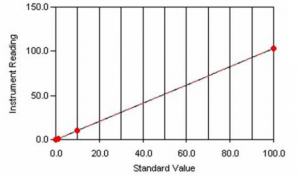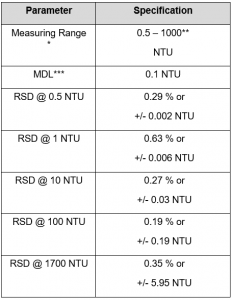Turbidity
Method Abstract #60
Scope and Application
This method conforms to Standard Method 2130 B, ASTM D 1889 and EPA 180.1 (White Light), ISO 7027 and EN 27027 (Infrared). It determines the amount of suspended particles in a solution, measured in nephelometric turbidity units (NTU) or nephelometric formazin units (NFU), and is used as a general indicator of the quality of water.
Method Summary
This method employs the use of a turbidity meter with a tungsten white light source to meet US EPA requirements. The method involves shining light into a sample and recording the light scattered at 90 degrees to the light path. Alternatively, to minimize the influence of color in a solution, an infrared (IR) turbidity meter may be used. Use of an IR light source is required to conform to ISO 7027/EN 27027.
Sample Calibration Curve
Method Performance
*This measuring range was determined by analyzing laboratory-prepared standards. The reporting limits were determined based on data obtaining a coefficient of variance better than 30%. RSD values are based on x10 replicates of standards run in a controlled environment. Results, repeat-ability, and recovery rates may differ depending on laboratory practices and sample matrix.
**Higher concentrations can be measured with pre-dilution or automated dilution using MT series analyzers
***The Method Detection Limit (MDL) refers to the minimum concentration of a substance that can be measured and reported with 99% confidence that the analyte concentration is greater than zero. The MDL calculation procedure was obtained from US EPA 40 CFR Appendix B to Part 136 – Definition and Procedure for the Determination of the Method Detection Limit.


